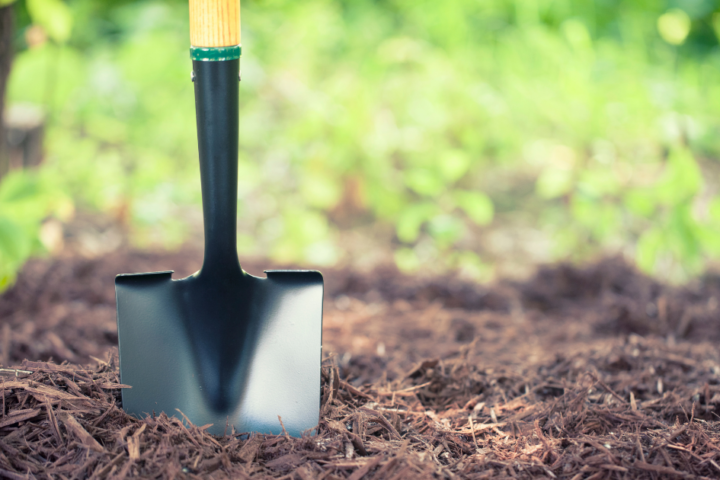May 8, 2022
5+ Mulching Tips to Keep Your Property Looking Neat and Clean

This time of year, everyone enjoys getting outside and making their properties look better with new plants and flowers. One of the best—and often overlooked— ways to make a landscape look new is with fresh mulch.
So we’re here with some mulching tips to help you spruce up your property.
Mulch for Landscapes
You may be wondering, “Why bother putting mulch in your landscape? Does it do anything besides make your flowerbeds look nicer?”
Mulch is made up of pretty much any decomposing organic material. Mulch can do great things for your gardens, trees, and flowerbeds when properly applied. It retains moisture, controls soil temperatures, and prohibits weeds, which benefit your plants.
Mulch for landscapes has been around for centuries. Archaeologists found that people in the Stone Age used…well…stones in their gardens as mulch. The Scottish and Irish perfected the use of seaweed as mulch long ago (and still use it today). But it wasn’t until the 1960s that hardwood mulch became a big deal in the United States.
Around that time, there was a huge boom in the lumber industry along the east coast. Sawmills had to do something with the large amounts of bark scraps that were piling up. So they ground it up a little finer and began selling it as mulch.
It had everything good mulch needs:
- it was in small fine pieces (making it easier to decompose)
- the dark color lasted a long time (making it naturally attractive)
- it was organic (totally natural with nothing added).
About the time Americans started getting hooked on the look of mulch in their landscaping, lumber operations began declining in the U.S. and moving overseas. To keep up with demand, mulch companies started using other scraps of wood (even broken down pallets with the occasional nail included) and adding dyes to create the illusion of natural browns, blacks, and reds.
Whether you choose bags of mulch from a big box store, have a scoop loaded into your truck at the mulch yard, or use any number of other materials (pine straw, leaves, grass clippings, etc.), adding mulch into your landscape can only make things better—if you do it right at the right time.
Best Time to Mulch
The best time to mulch is mid-to-late spring. It is usually at this time that most gardeners and landscapers are putting out new plants, and they can benefit from having the blanket of protection and moisture control that mulch provides.
If you are growing garden crops from seeds in the spring, young plants can usually push their way through a thin layer of mulch with no problems. Later, you can always come back and add more after they have gotten more established.
Really, you can mulch any time of the year, and it will help your plants. Later in the summer, as temperatures rise (especially here in the Dallas/Fort Worth area!), you may find that adding more mulch around heat-intolerant plants helps them survive and keep looking good. Likewise, trees and shrubs left in the cold, enduring freezing and thawing along with harsh winter winds, will do better with additional mulch.
But not too much!
How Much Mulch Do I Need?
Over the past several decades, as the popularity of mulch has grown (it’s hard to find a professionally landscaped area that doesn’t have any), the thinking seems to have become “if a little is good…a lot is better.”
But when it comes to mulch, nothing could be further from the truth!
It is definitely possible to put down too much mulch, especially around trees. The look of deep, smooth mounds of mulch at the base of trees (sometimes a foot or two high) in commercially landscaped properties is what many refer to as “mulch volcanoes.”
It comes from clients who want mulch to be “pretty” and landscape companies who don’t really understand how mulch works. And because homeowners assume that professional landscape companies must be doing it right, they create mulch volcanoes in their own yards.
And trees everywhere are suffering because of it.
A 1- to 2-inch layer of mulch should be all you need to suppress weeds and provide plants with the protection they need. If the material you’re using is made of bigger individual pieces, you may want to apply it 3- to 4- inches deep. Any more than that, and you begin to risk suffocating the plants or creating an environment where diseases and rodent problems can develop.
Mulching Tips and Tricks
- Calculate how much mulch you need with a mulch and soil calculator like this one from Lowe’s.
- Keep mulch 1- to 2-inches away from plant stems and tree trunks.
- Help prevent termites by keeping mulch several inches away from the foundation of your home.
- Use heavier mulches on slopes or in places where lighter ones (like pine bark nuggets) will wash away.
- Use a small bucket to spread mulch in tight spaces more efficiently.
- If they need it, trim shrubs before mulching. The mulch will cover clippings you miss. If you mulch before you trim, the clippings look bad, and you end up raking out mulch with them.
The #1 Tip For Mulching…
One last tip: for excellent mulch coverage that won’t break your back, hire a pro!
At LH Services, mulching the landscapes we design, create, and maintain is second nature. It’s just one of the many services we offer.
To see the difference we can make on your property, schedule a free estimate today!
